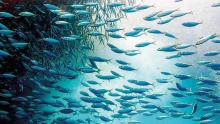Climatology
US weather whiplash shows climate change
A series of "once-in-a-millennium" rainstorms have lashed the United States in recent weeks, flooding areas baked dry by long-term droughts, as human-caused climate change brings weather whiplash.
And scientists warn that global warming means once-rare events are already much more likely, upending the models they have long used to predict possible disasters, with worse to come.
- Read more about US weather whiplash shows climate change
- Log in to post comments
China warns of ‘severe’ threat to harvest from worst heatwave on record
China's autumn harvest is under "severe threat" from high temperatures and drought, authorities have warned, urging action to protect crops in the face of the country's hottest summer on record.
Lowest July Antarctic sea ice on record
Last month saw the lowest extent of Antarctic sea ice on record for July, according to the European Union's satellite monitoring group.
The Copernicus Climate Change Service (C3S) found Antarctic sea ice extent reached 15.3 million square kilometers - some 1.1 million km2, or seven percent, below the 1991-2020 average for July.
- Read more about Lowest July Antarctic sea ice on record
- Log in to post comments
Three Scientists Share Nobel Prize in Physics
The 2021 Nobel Prize for physics has been shared between scientists working on models to predict global warming and the interplay of planetary systems.
One half of the prize is split between Syukuro Manabe and Klaus Hasselmann for their work in the 'physical modelling of Earth's climate, quantifying variability and reliably predicting global warming.'
- Read more about Three Scientists Share Nobel Prize in Physics
- Log in to post comments
Global warming threatens marine life in Black Sea
Due to the effect of global warming, the water temperature of the Black Sea is rising abnormally, so much so that the marine biome of the partly-landlocked sea has come under a dire threat, Turkish experts have said
- Read more about Global warming threatens marine life in Black Sea
- Log in to post comments
Rain on Greenland ice sheet signals climate change risk
Rain fell at the highest point on Greenland's ice sheet - possibly for the first time - in an event Danish scientists on Aug. 23 said was most likely driven by climate change.
class='cf'>
The rain was observed for several hours on August 14 at a measuring post more than 3,000 meters (9,800 feet) up on the sheet, the U.S. Snow and Ice Data Center reported.
Study Says Recent Heat Wave in North America Likely Linked to Global Climate Change
A record-breaking heat wave that hit the western United States and Canada at the end of June would have been "virtually impossible" without human-caused climate change, according to an analysis by a group of leading climate scientists.
"This is not normal"; An extreme map has been made, Serbia is on it? PHOTO
Climatologists have been warning about these extremes for months due to climate change, but the question also arises as to whether all these extremes are common for June.
Arctic sizzled in 2020, the warmest year for Europe too
Europe endured record heat and rainfall last year while temperatures in Arctic Siberia soared off the charts, the European Union's climate monitoring service reported on April 22.
The continent in 2020 was nearly half a degree Celsius hotter than the next warmest year, according to the Copernicus Climate Change Service (C3S).
Year 2020 Competes with 2016 as Warmest on Record
2020 has tied 2016 as the hottest year on record, the European Union's climate monitoring service said Friday, keeping Earth on a global warming fast track that could devastate large swathes of humanity.
- Read more about Year 2020 Competes with 2016 as Warmest on Record
- Log in to post comments










